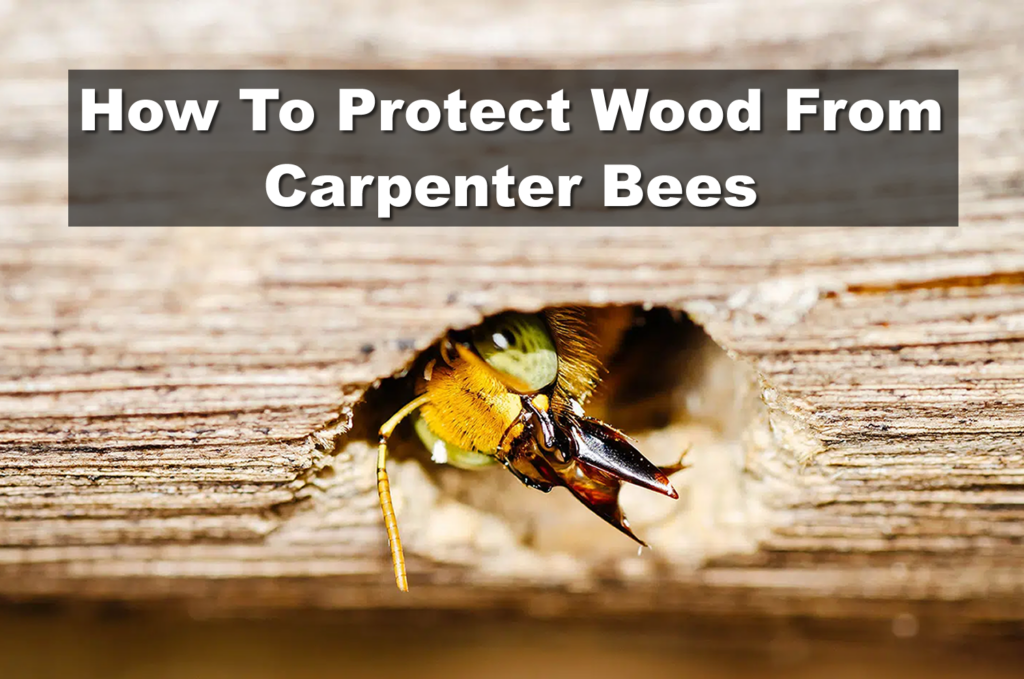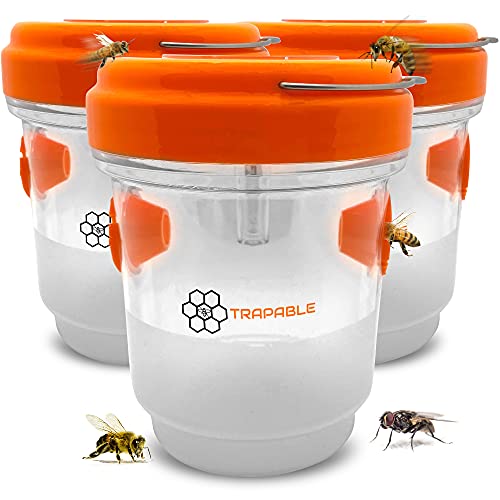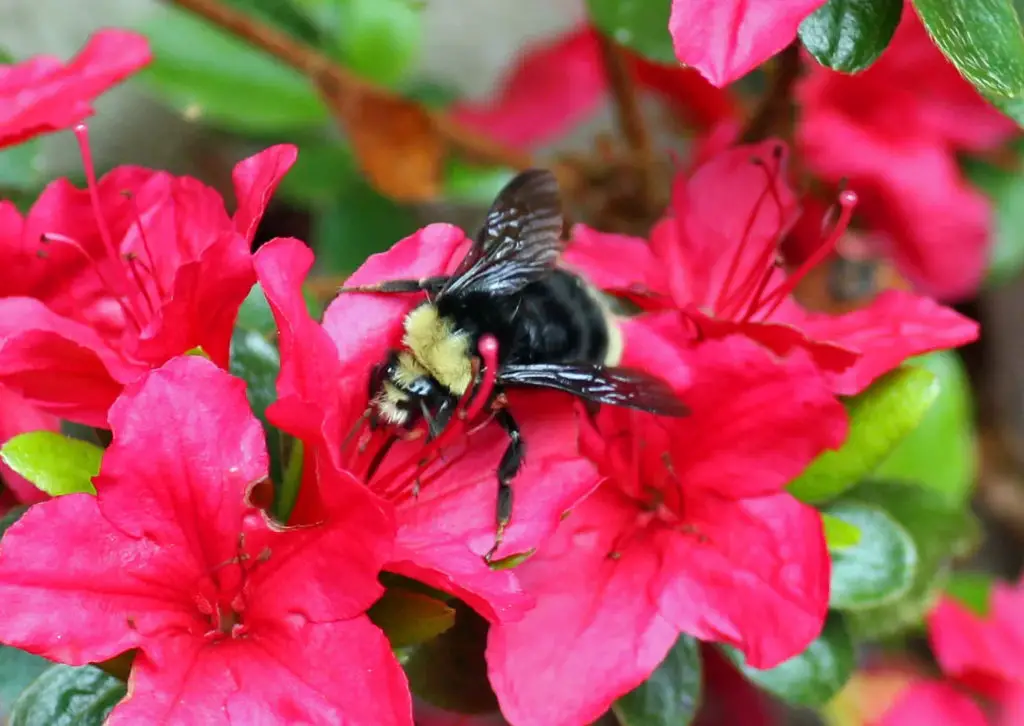Affiliate Disclaimer - As an Amazon Associate I earn from qualifying purchases.
It supports the website. So, Thank you
Carpenter bees are truly wonderful creatures but when they start drilling holes into your wooden structures, they suddenly become much more of a pest. I’m all for making sure that we always deter bees in the most natural and harmless ways so this leads me to ask how to protect wood from carpenter bees without hurting them.
There are several things you can do to stop carpenter bees from drilling holes in your wood. Choosing hardwood is always a good option or you can make sure to seal entry points. In the most extreme cases, you may need to set carpenter bee traps but keep in mind that this will kill the bees.
In this guide, I’m going to talk you through some great ways to prevent carpenter bees from damaging wood.
Table of Contents
What Do Carpenter Bees Do To Wood?
It probably won’t come as much of a surprise that carpenter bees enjoy wood; the clue is in the name, after all. These flying insects bore into wood by drilling small circular holes in order to make tunnels.
A lot of people mistakenly believe that they do this for food, but carpenter bees do not eat wood. Instead, they create these holes and tunnels for nesting.
Unlike other bee species such as the honey bee, which lives in large colonies, carpenter bees are lonesome animals that make their own individual nests. And they love to do this in wood.

How To Protect Wood From Carpenter Bees
If you’ve been having problems with carpenter bees boring holes into your wood then there are a few things you can do to stop this. In my opinion, the best way to stop bees from becoming a pest is to use natural methods. While we do want to deter them, causing them harm and killing them is not beneficial to the local ecosystem so it’s not something I’d ever recommend.
Keep Them Away With Scents
One of the best ways to keep carpenter bees away from your property and therefore your wood is to deter them using scents. Citrus works wonderfully as the bees cannot stand the smell and it’s super easy to make a citrus spray using things you already have at home.
It’s as simple as boiling citrus fruit peel in water and then putting this into a spray bottle and dousing the problem areas. You’ll want to repeat the application every few days in order for it to be most effective. But this is an excellent option if you’ve got bees nesting in your patio furniture or kid’s wooden swing set.
Almond oil is another brilliant scent that’ll keep carpenter bees away from your wooden structures. The scent, for all intents and purposes, acts in the same way as citrus and when sprayed onto the wood, will stop carpenter bees from nesting in it. Make sure to mix the oil with some water before applying it and put it directly into the holes.
Use Hardwood
When you are building wooden structures in your backyard, it’s worth looking at the type of wood you are using. Hardwood is far less favorable to carpenter bees who prefer soft, untreated wood. Simply using a treated hardwood could be all the deterrent you need.
Treat And Paint Your Wood
As I have just mentioned, carpenter bees prefer wood that has not been treated. The simple act of painting or treating your wooden items could be one of the most effective ways to deter these creatures from nesting.
Moreover, it’s really important to monitor your wooden structures and regularly check them for carpenter bee holes. If you notice anything then you’ll want to seal these holes immediately. If they are not properly sealed, then the chances of the bees continuing to nest are very high.
I’d recommend sealing any holes first and then applying paint or treatment. The problem is that carpenter bees will return to the same nesting spots and since they live for a few years, you will only see them coming back if the wood is not treated.
Deter Them With Sounds
It might sound a little strange but playing your favorite band at a high volume could be enough to send carpenter bees packing. It’s been proven that these bees do not like loud sounds. The vibrations from the speakers are very unpleasant to carpenter bees and by playing loud music, you’ll get them to flee the nests they’ve made.
However, they’ll only go for a short period of time. Once the sound stops, there’s a very good chance that they’ll return. But what this does do is give you the opportunity to seal up any holes they’ve made in the wood, preventing them from getting back into the nests when they come back.
I would use this in conjunction with other methods such as spraying the wood with citrus. Otherwise, you may find that they simply drill new holes.
Consider Using Other Materials
It’s worth asking yourself whether you really need to use wood for certain structures. Yes, it’s a durable and attractive material but if you live in an area where carpenter bees are rife, is it really worth the hassle?
There are plenty of alternative materials you could use including composites that look very much like wood. You’ll still get the aesthetic benefits without the need for high maintenance and carpenter bees won’t show any interest.
The Last Resort
If you have tried all of the above methods and still find that you have problems with carpenter bees then it may be time to consider something a little more severe. As I have discussed, I would never advocate harming or killing bees unless the circumstances are very extreme. Bees are an essential part of any ecosystem and, where possible, should be left to nest in peace.
But, if you really need to then it is possible to buy carpenter bee traps. These traps entice the carpenter bees by looking and feeling just like their natural habitats. They’re usually made from softwood that carpenter bees love so it instantly draws them in.
When using a carpenter bee trap, you’ll need to make sure that you hang it in a high position in the sun. Most traps are designed to be hung vertically, so do keep this in mind. Although you’ll get instructions with the trap to tell you how to use it properly.
The best place to hang a carpenter bee trap is in the corner of the property as this is where they’re most naturally drawn. Of course, if you’re having issues in a particular area then hanging the trap close to this is going to make the most sense.
A lot of people wonder whether you need to bait a carpenter bee trap but it’s really not necessary. Of course, you can if you want to but it’s really the pheromones of other bees that’ll entice more carpenters to explore the trap.
When a bee dies, it releases alarm pheromones that summon others. When a bee enters the trap, dies, and its pheromones are released, this will be pretty much all you need for other bees to come flocking.
Conclusion
Carpenter bees can be a real problem when they start nesting in the wooden structures around the home and garden. While they are aggressive creatures, most of us don’t want to share our homes with them.
So, you’re probably wondering how to protect wood from carpenter bees. Quite simply, using treated hardwood is one of the best deterrents as these bees prefer soft, untreated wood. You can also use natural methods like spraying the wood with citrus or you could consider using other materials.
While it is possible to use a carpenter bee trap, I’d only recommend this when all else fails as we don’t want to harm bees when we don’t need to.










